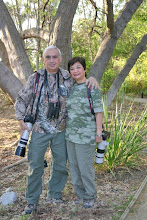Our recent trip to the Las Pinas-Paranaque Critical Habitat and Ecotourism Area (LPPCHEA) gave that term a new meaning. It became more literal. We were amazed as to how birds could thrive in an environment that is full of garbage.
Here are a couple of examples: Apparently both species were getting food amongst the debris. We saw them foraging and pecking at places where the soil was covered with plastics, shoes, backpacks and other stuff of every imaginable kind. It was such that both brown birds were difficult to see much less photograph. When I saw a bird I would describe its location to our friend, Peter, like, "it's in front of that pink plastic bag" or "it's right beside the red bag of chips".
The resident Common Sandpiper was so "at home" and was obviously unmindful of its messy surroundings.
The cute migrant Pacific Golden Plover, however, looked so out of place here. It was like a lovely girl model posing beside a trash bin.
Thankfully, some species knew how to avoid the trashy areas. Like the Grey-tailed Tattler.
Understandably with the kingfishers because their prey were in the waters anyway and not on the shoreline.
 |
| Collared Kingfisher |
 |
| Common Kingfisher |
 |
| Black-crowned Night Heron |
 |
| Little Egret |
 |
| Whiskered Tern |






No comments:
Post a Comment